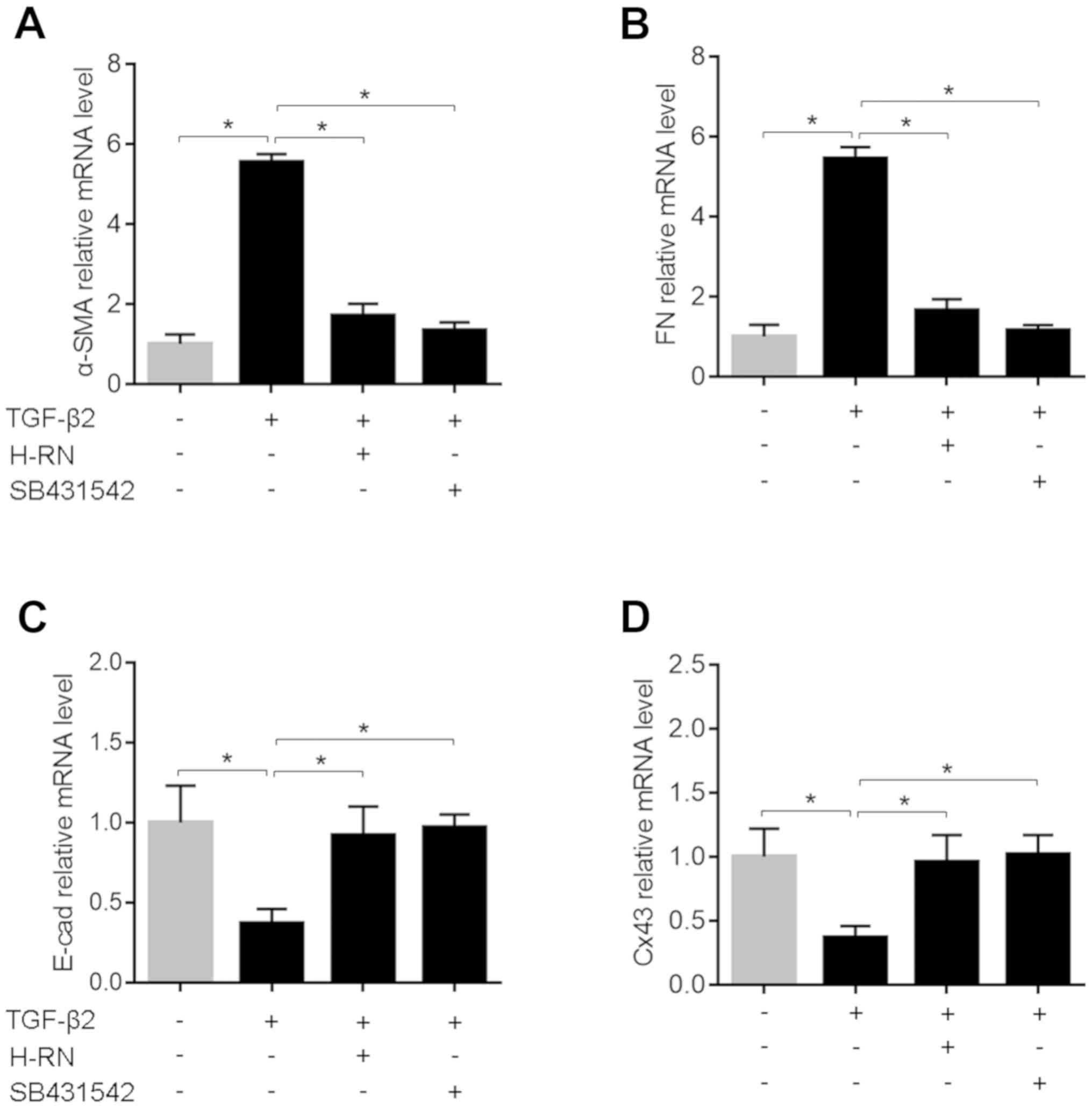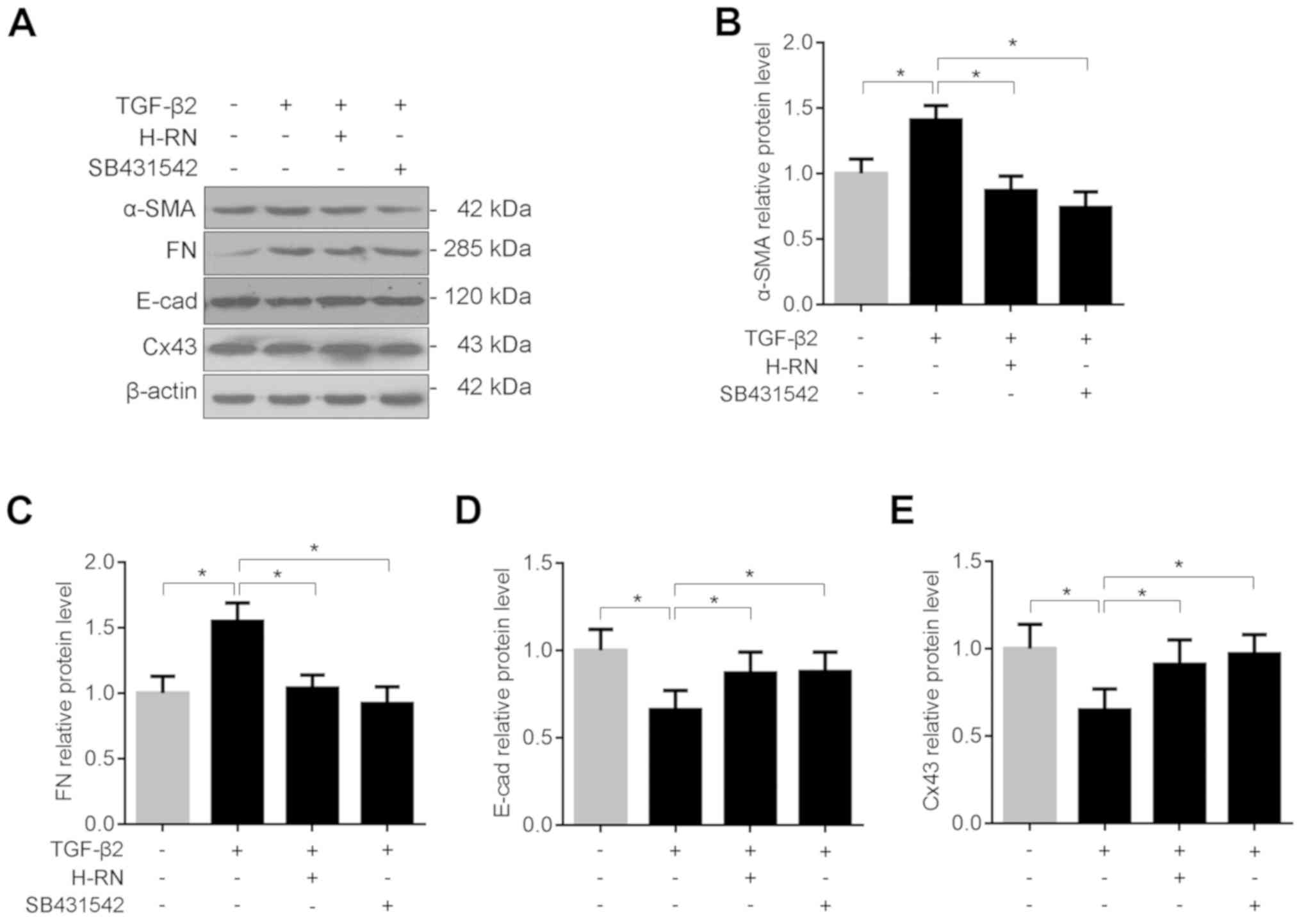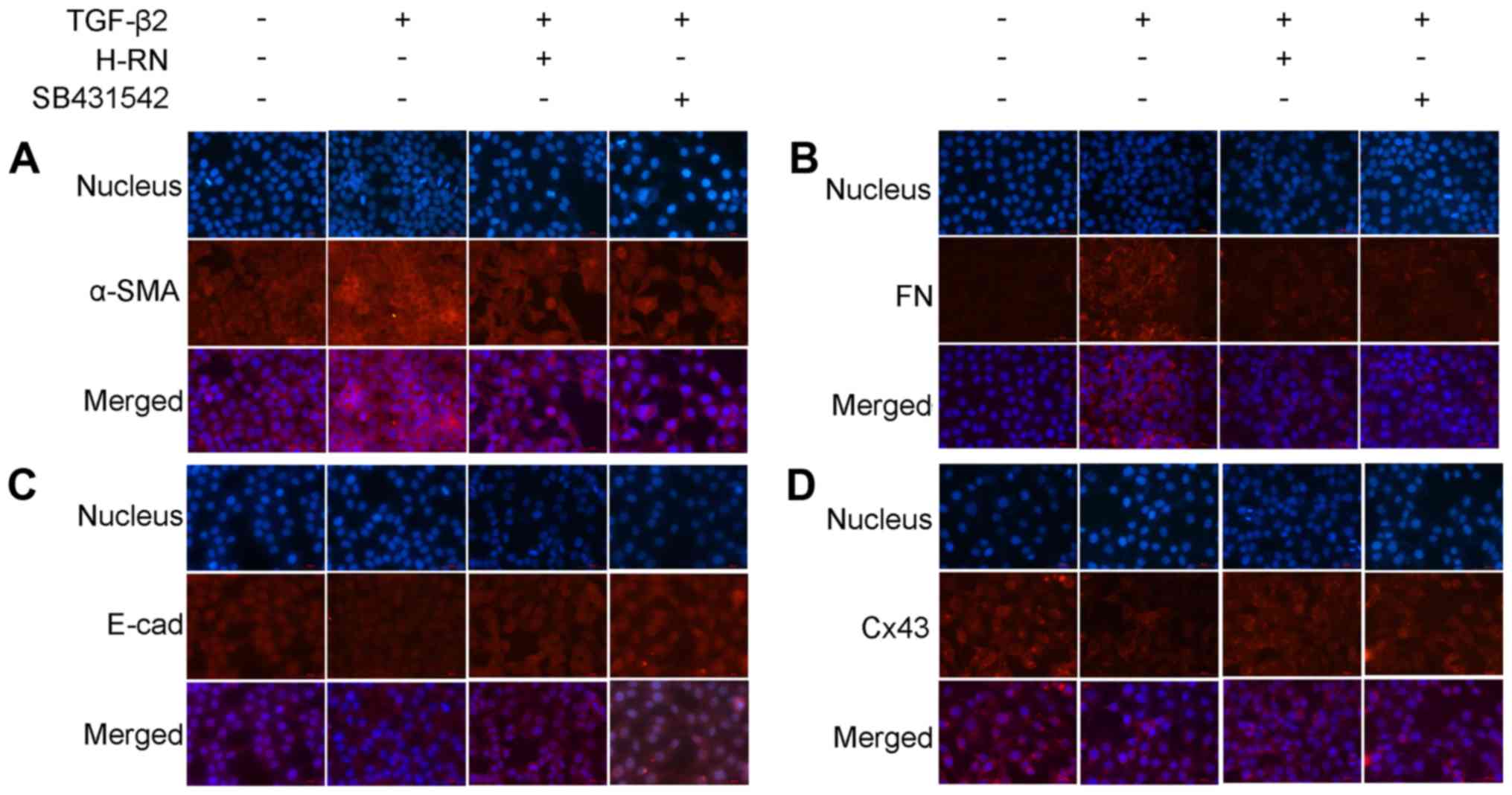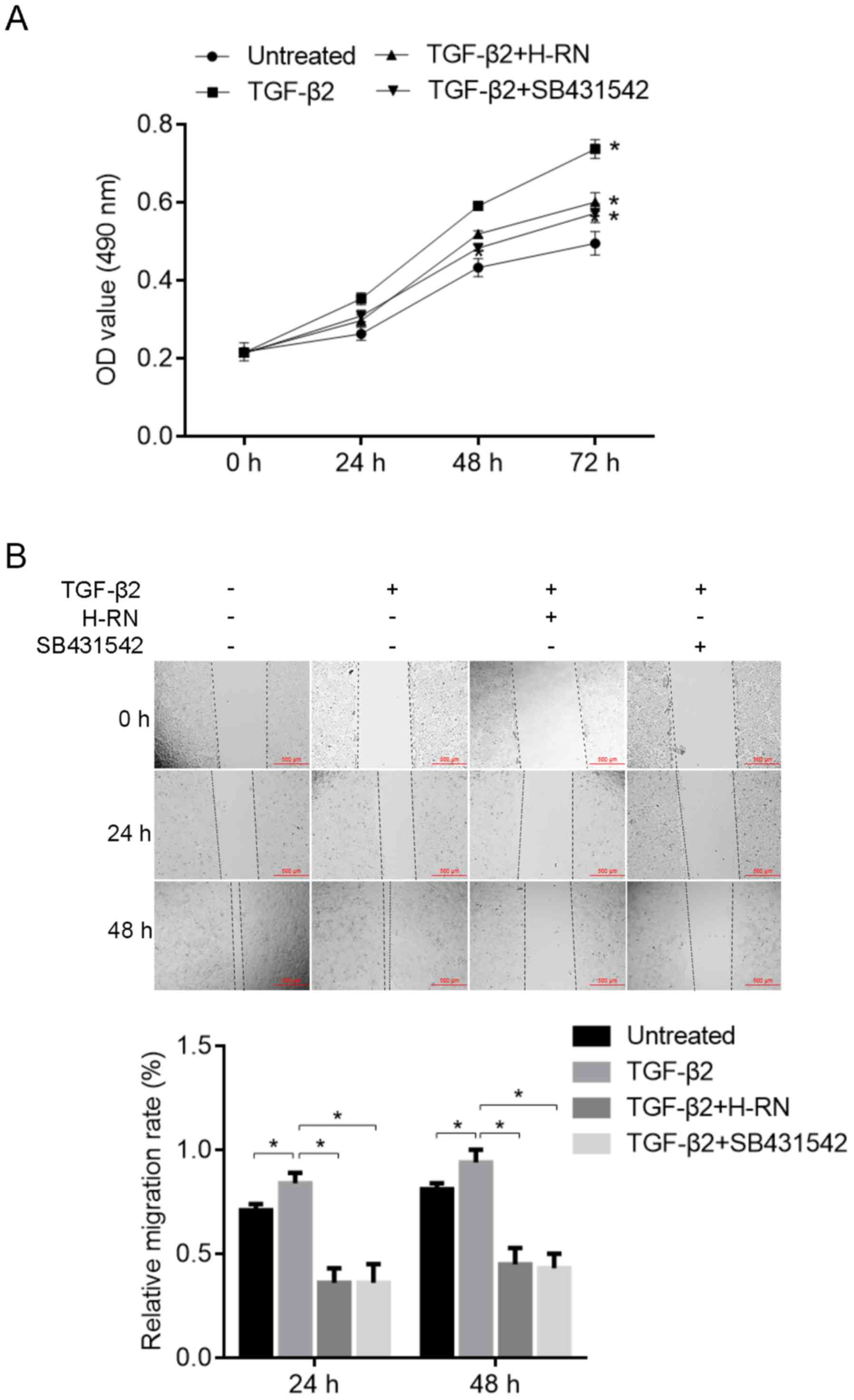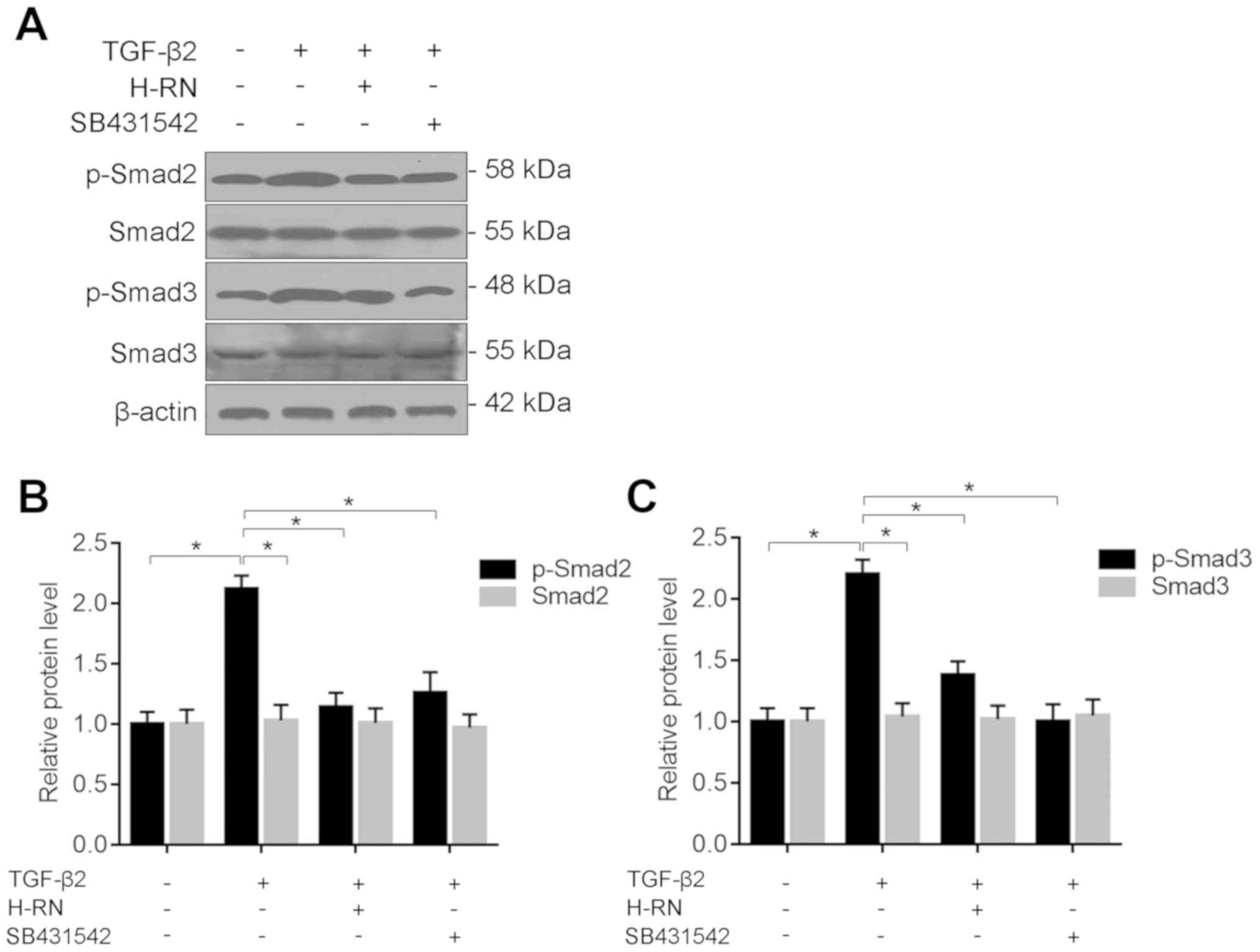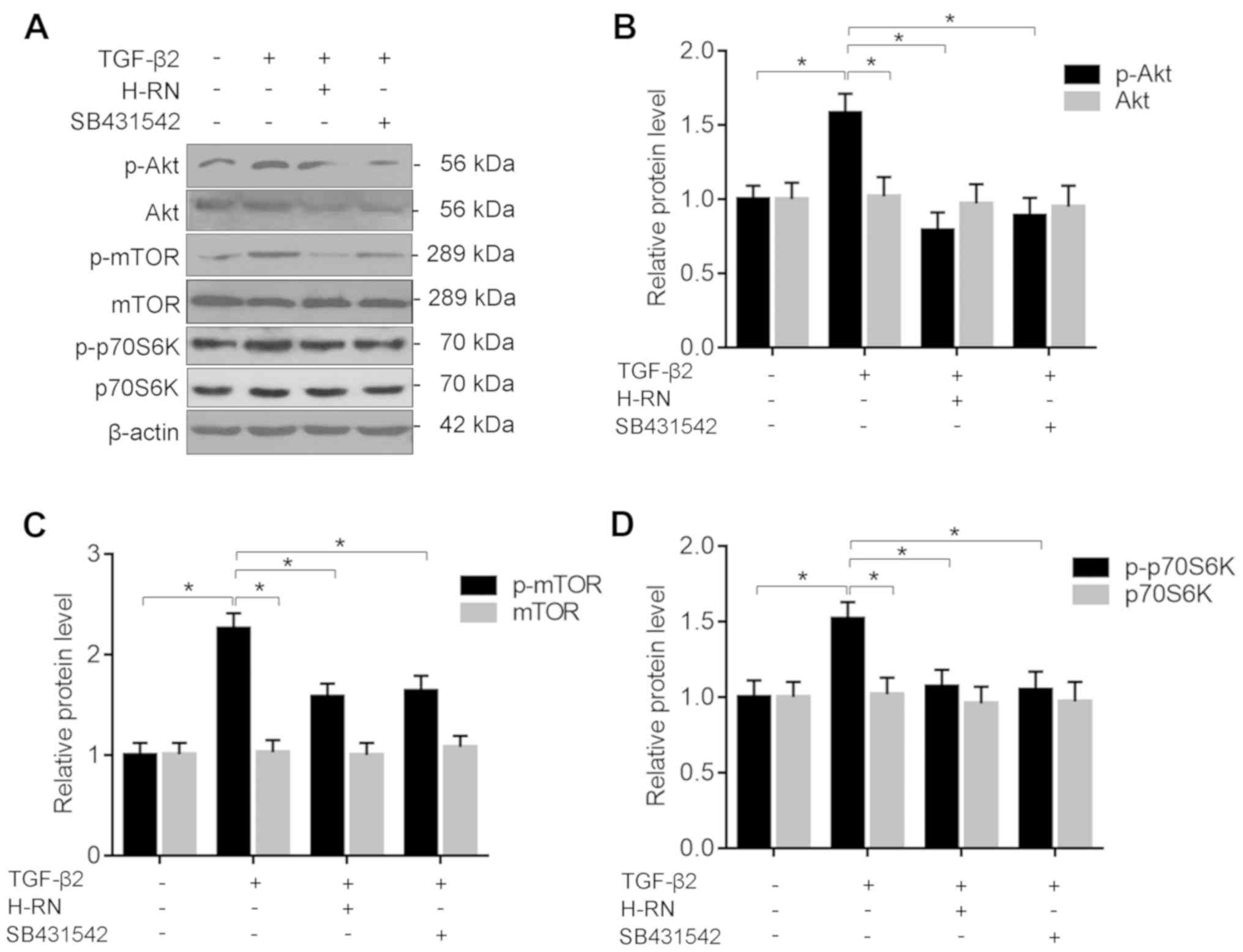|
1
|
Ebihara Y, Kato S, Oshika T, Yoshizaki M
and Sugita G: Posterior capsule opacification after cataract
surgery in patients with diabetes mellitus. J Cataract Refract
Surg. 32:1184–1187. 2006. View Article : Google Scholar : PubMed/NCBI
|
|
2
|
Zukin LM, Pedler MG, Groman-Lupa S,
Pantcheva M, Ammar DA and Petrash JM: Aldose Reductase Inhibition
Prevents Development of Posterior Capsular Opacification in an In
Vivo Model of Cataract Surgery. Invest Ophthalmol Vis Sci.
59:3591–3598. 2018. View Article : Google Scholar : PubMed/NCBI
|
|
3
|
Wormstone IM and Eldred JA: Experimental
models for posterior capsule opacification research. Exp Eye Res.
142:2–12. 2016. View Article : Google Scholar : PubMed/NCBI
|
|
4
|
Valcourt U, Kowanetz M, Niimi H, Heldin CH
and Moustakas A: TGF-beta and the Smad signaling pathway support
transcriptomic reprogramming during epithelial-mesenchymal cell
transition. Mol Biol Cell. 16:1987–2002. 2005. View Article : Google Scholar : PubMed/NCBI
|
|
5
|
Yao K, Ye PP, Tan J, Tang XJ and Shen Tu
XC: Involvement of PI3K/Akt pathway in TGF-beta2-mediated
epithelial mesenchymal transition in human lens epithelial cells.
Ophthalmic Res. 40:69–76. 2008. View Article : Google Scholar : PubMed/NCBI
|
|
6
|
Nahomi RB, Pantcheva MB and Nagaraj RH:
αB-crystallin is essential for the TGF-β2-mediated epithelial to
mesenchymal transition of lens epithelial cells. Biochem J.
473:1455–1469. 2016. View Article : Google Scholar : PubMed/NCBI
|
|
7
|
Hou M, Bao X, Luo F, Chen X, Liu L and Wu
M: HMGA2 Modulates the TGFβ/Smad, TGFβ/ERK and Notch Signaling
Pathways in Human Lens Epithelial-Mesenchymal Transition. Curr Mol
Med. 18:71–82. 2018. View Article : Google Scholar : PubMed/NCBI
|
|
8
|
Wormstone IM, Tamiya S, Anderson I and
Duncan G: TGF-beta2-induced matrix modification and cell
transdifferentiation in the human lens capsular bag. Invest
Ophthalmol Vis Sci. 43:2301–2308. 2002.PubMed/NCBI
|
|
9
|
Gotoh N, Perdue NR, Matsushima H, Sage EH,
Yan Q and Clark JI: An in vitro model of posterior capsular
opacity: SPARC and TGF-beta2 minimize epithelial-to-mesenchymal
transition in lens epithelium. Invest Ophthalmol Vis Sci.
48:4679–4687. 2007. View Article : Google Scholar : PubMed/NCBI
|
|
10
|
Leight JL, Wozniak MA, Chen S, Lynch ML
and Chen CS: Matrix rigidity regulates a switch between
TGF-β1-induced apoptosis and epithelial-mesenchymal transition. Mol
Biol Cell. 23:781–791. 2012. View Article : Google Scholar : PubMed/NCBI
|
|
11
|
Zhu XJ, Chen MJ, Zhang KK, Yang J and Lu
Y: Elevated TGF-β2 level in aqueous humor of cataract patients with
high myopia: Potential risk factor for capsule contraction
syndrome. J Cataract Refract Surg. 42:232–238. 2016. View Article : Google Scholar : PubMed/NCBI
|
|
12
|
Livitsanou M, Vasilaki E, Stournaras C and
Kardassis D: Modulation of TGFβ/Smad signaling by the small GTPase
RhoB. Cell Signal. 48:54–63. 2018. View Article : Google Scholar : PubMed/NCBI
|
|
13
|
Meng F, Li J, Yang X, Yuan X and Tang X:
Role of Smad3 signaling in the epithelial-mesenchymal transition of
the lens epithelium following injury. Int J Mol Med. 42:851–860.
2018.PubMed/NCBI
|
|
14
|
Wormstone IM, Anderson IK, Eldred JA,
Dawes LJ and Duncan G: Short-term exposure to transforming growth
factor beta induces long-term fibrotic responses. Exp Eye Res.
83:1238–1245. 2006. View Article : Google Scholar : PubMed/NCBI
|
|
15
|
Sun CB, Teng WQ, Cui JT, Huang XJ and Yao
K: The effect of anti-TGF-β2 antibody functionalized intraocular
lens on lens epithelial cell migration and epithelial-mesenchymal
transition. Colloids Surf B Biointerfaces. 113:33–42. 2014.
View Article : Google Scholar : PubMed/NCBI
|
|
16
|
Albericio F and Kruger HG: Therapeutic
peptides. Future Med Chem. 4:1527–1531. 2012. View Article : Google Scholar : PubMed/NCBI
|
|
17
|
Fosgerau K and Hoffmann T: Peptide
therapeutics: Current status and future directions. Drug Discov
Today. 20:122–128. 2015. View Article : Google Scholar : PubMed/NCBI
|
|
18
|
Craik DJ, Fairlie DP, Liras S and Price D:
The future of peptide-based drugs. Chem Biol Drug Des. 81:136–147.
2013. View Article : Google Scholar : PubMed/NCBI
|
|
19
|
Lau JL and Dunn MK: Therapeutic peptides:
Historical perspectives, current development trends, and future
directions. Bioorg Med Chem. 26:2700–2707. 2018. View Article : Google Scholar : PubMed/NCBI
|
|
20
|
Sato AK, Viswanathan M, Kent RB and Wood
CR: Therapeutic peptides: Technological advances driving peptides
into development. Curr Opin Biotechnol. 17:638–642. 2006.
View Article : Google Scholar : PubMed/NCBI
|
|
21
|
Mohammed I, Said DG and Dua HS: Human
antimicrobial peptides in ocular surface defense. Prog Retin Eye
Res. 61:1–22. 2017. View Article : Google Scholar : PubMed/NCBI
|
|
22
|
Brandt CR: Peptide therapeutics for
treating ocular surface infections. J Ocul Pharmacol Ther.
30:691–699. 2014. View Article : Google Scholar : PubMed/NCBI
|
|
23
|
Xu Y, Zhao H, Zheng Y, Gu Q, Ma J and Xu
X: A novel antiangiogenic peptide derived from hepatocyte growth
factor inhibits neovascularization in vitro and in vivo. Mol Vis.
16:1982–1995. 2010.PubMed/NCBI
|
|
24
|
Sun Y, Su L, Wang Z, Xu Y and Xu X: H-RN,
a peptide derived from hepatocyte growth factor, inhibits corneal
neovascularization by inducing endothelial apoptosis and arresting
the cell cycle. BMC Cell Biol. 14:82013. View Article : Google Scholar : PubMed/NCBI
|
|
25
|
Wang L, Xu Y, Yu Q, Sun Q, Xu Y, Gu Q and
Xu X: H-RN, a novel antiangiogenic peptide derived from hepatocyte
growth factor inhibits inflammation in vitro and in vivo through
PI3K/AKT/IKK/NF-κB signal pathway. Biochem Pharmacol. 89:255–265.
2014. View Article : Google Scholar : PubMed/NCBI
|
|
26
|
Zhu S, Xu X, Wang L, Su L, Gu Q, Wei F and
Liu K: Inhibitory effect of a novel peptide, H-RN, on keratitis
induced by LPS or poly(I:C) in vitro and in vivo via suppressing
NF-κB and MAPK activation. J Transl Med. 15:202017. View Article : Google Scholar : PubMed/NCBI
|
|
27
|
Jin H, Yang X, Liu K, Gu Q and Xu X:
Effects of a novel peptide derived from human thrombomodulin on
endotoxin-induced uveitis in vitro and in vivo. FEBS Lett.
585:3457–3464. 2011. View Article : Google Scholar : PubMed/NCBI
|
|
28
|
Xu Y, Xu X, Jin H, Yang X, Gu Q and Liu K:
Effects of a thrombomodulin-derived peptide on monocyte adhesion
and intercellular adhesion molecule-1 expression in
lipopolysaccharide-induced endothelial cells. Mol Vis. 19:203–212.
2013.PubMed/NCBI
|
|
29
|
Zhu S, Xu X, Liu K, Gu Q and Yang X:
PAPep, a small peptide derived from human pancreatitis-associated
protein, attenuates corneal inflammation in vivo and in vitro
through the IKKα/β/IκBα/NF-κB signaling pathway. Pharmacol Res.
102:113–122. 2015. View Article : Google Scholar : PubMed/NCBI
|
|
30
|
Yang X, Jin H, Liu K, Gu Q and Xu X: A
novel peptide derived from human pancreatitis-associated protein
inhibits inflammation in vivo and in vitro and blocks NF-kappa B
signaling pathway. PLoS One. 6:e291552011. View Article : Google Scholar : PubMed/NCBI
|
|
31
|
Livak KJ and Schmittgen TD: Analysis of
relative gene expression data using real-time quantitative PCR and
the 2(-Delta Delta C(T)) Method. Methods. 25:402–408. 2001.
View Article : Google Scholar : PubMed/NCBI
|
|
32
|
Uboveja A, Satija YK, Siraj F, Sharma I
and Saluja D: p73 - NAV3 axis plays a critical role in suppression
of colon cancer metastasis. Oncogenesis. 9:122020. View Article : Google Scholar : PubMed/NCBI
|
|
33
|
Slingsby C and Wistow GJ: Functions of
crystallins in and out of lens: Roles in elongated and post-mitotic
cells. Prog Biophys Mol Biol. 115:52–67. 2014. View Article : Google Scholar : PubMed/NCBI
|
|
34
|
Liu L and Xiao W: Notch1 signaling induces
epithelial-mesenchymal transition in lens epithelium cells during
hypoxia. BMC Ophthalmol. 17:1352017. View Article : Google Scholar : PubMed/NCBI
|
|
35
|
Liu T, Zhang L, Wang Y, Zhang H, Li L and
Bao X: Dickkopf-1 inhibits Wnt3a-induced migration and
epithelial-mesenchymal transition of human lens epithelial cells.
Exp Eye Res. 161:43–51. 2017. View Article : Google Scholar : PubMed/NCBI
|
|
36
|
Zhang G, Kang L, Chen J, Xue Y, Yang M,
Qin B, Yang L, Zhang J, Lu H and Guan H: CtBP2 Regulates
TGFβ2-Induced Epithelial-Mesenchymal Transition Through Notch
Signaling Pathway in Lens Epithelial Cells. Curr Eye Res.
41:1057–1063. 2016. View Article : Google Scholar : PubMed/NCBI
|
|
37
|
Cerra A, Mansfield KJ and Chamberlain CG:
Exacerbation of TGF-beta-induced cataract by FGF-2 in cultured rat
lenses. Mol Vis. 9:689–700. 2003.PubMed/NCBI
|
|
38
|
Wei Z, Caty J, Whitson J, Zhang AD,
Srinivasagan R, Kavanagh TJ, Yan H and Fan X: Reduced Glutathione
Level Promotes Epithelial-Mesenchymal Transition in Lens Epithelial
Cells via a Wnt/β-Catenin-Mediated Pathway: Relevance for Cataract
Therapy. Am J Pathol. 187:2399–2412. 2017. View Article : Google Scholar : PubMed/NCBI
|
|
39
|
Sánchez-Duffhues G, García de Vinuesa A
and Ten Dijke P: Endothelial-to-mesenchymal transition in
cardiovascular diseases: Developmental signaling pathways gone
awry. Dev Dyn. 247:492–508. 2018. View Article : Google Scholar : PubMed/NCBI
|
|
40
|
Ha GH, Park JS and Breuer EK: TACC3
promotes epithelial-mesenchymal transition (EMT) through the
activation of PI3K/Akt and ERK signaling pathways. Cancer Lett.
332:63–73. 2013. View Article : Google Scholar : PubMed/NCBI
|
|
41
|
Gulhati P, Bowen KA, Liu J, Stevens PD,
Rychahou PG, Chen M, Lee EY, Weiss HL, O'Connor KL, Gao T, et al:
mTORC1 and mTORC2 regulate EMT, motility, and metastasis of
colorectal cancer via RhoA and Rac1 signaling pathways. Cancer Res.
71:3246–3256. 2011. View Article : Google Scholar : PubMed/NCBI
|
|
42
|
De Silva DM, Roy A, Kato T, Cecchi F, Lee
YH, Matsumoto K and Bottaro DP: Targeting the hepatocyte growth
factor/Met pathway in cancer. Biochem Soc Trans. 45:855–870. 2017.
View Article : Google Scholar : PubMed/NCBI
|
|
43
|
Kataoka H, Kawaguchi M, Fukushima T and
Shimomura T: Hepatocyte growth factor activator inhibitors (HAI-1
and HAI-2): Emerging key players in epithelial integrity and
cancer. Pathol Int. 68:145–158. 2018. View Article : Google Scholar : PubMed/NCBI
|
|
44
|
Colombo ES, Menicucci G, McGuire PG and
Das A: Hepatocyte growth factor/scatter factor promotes retinal
angiogenesis through increased urokinase expression. Invest
Ophthalmol Vis Sci. 48:1793–1800. 2007. View Article : Google Scholar : PubMed/NCBI
|
|
45
|
Madonna R, Cevik C, Nasser M and De
Caterina R: Hepatocyte growth factor: Molecular biomarker and
player in cardioprotection and cardiovascular regeneration. Thromb
Haemost. 107:656–661. 2012. View Article : Google Scholar : PubMed/NCBI
|
|
46
|
Lu Q, Zhang L, Shen X, Zhu Y, Zhang Q,
Zhou Q, Gan R, Zhang H, Zhong Y and Xie B: A novel and effective
human hepatocyte growth factor kringle 1 domain inhibits ocular
neovascularization. Exp Eye Res. 105:15–20. 2012. View Article : Google Scholar : PubMed/NCBI
|
|
47
|
Chang PC, Wu HL, Lin HC, Wang KC and Shi
GY: Human plasminogen kringle 1–5 reduces atherosclerosis and
neointima formation in mice by suppressing the inflammatory
signaling pathway. J Thromb Haemost. 8:194–201. 2010. View Article : Google Scholar : PubMed/NCBI
|
|
48
|
Jin J, Zhou KK, Park K, Hu Y, Xu X, Zheng
Z, Tyagi P, Kompella UB and Ma JX: Anti-inflammatory and
antiangiogenic effects of nanoparticle-mediated delivery of a
natural angiogenic inhibitor. Invest Ophthalmol Vis Sci.
52:6230–6237. 2011. View Article : Google Scholar : PubMed/NCBI
|















